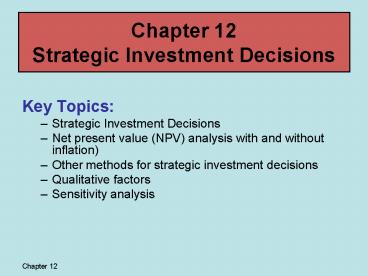Key Topics: PowerPoint PPT Presentation
1 / 20
Title: Key Topics:
1
Chapter 12 Strategic Investment Decisions
- Key Topics
- Strategic Investment Decisions
- Net present value (NPV) analysis with and without
inflation) - Other methods for strategic investment decisions
- Qualitative factors
- Sensitivity analysis
2
Strategic Investment Decisions
3
Short-Term Decisions
- Tend to be non-routine
- Effect operations over the next several months to
one year - Examples
4
Long-Term Decisions
- Usually involve large investments
- Project life is greater than 1 year
- Usually incorporate the time value of money
- Examples
5
Alternative Methods
- NPV (accountants favorite)
- IRR (sometimes finance folks like this one)
- Payback (often used in other countries)
- Accrual accounting rate of return (not useful for
project decision making)
6
Timeline for New Projects
7
Replace Old Equipment
8
NPV
- Time line
- Investment
- Cash inflows less cash outflows
- Discount cash flows
- Compare to investment
- NPV - investment discounted cash flows
9
NPV Analysis
- Investment rules based on NPV
- If the NPV is positive, accept the project.
- When choosing among various projects, choose the
one with the highest NPV or the highest
profitability index. - Assumptions
- All cash flows are certain (they are actually
uncertain) - Cash can be borrowed or loaned at the same
interest rate, and that rate is constant from
period to period (not very realistic).
10
IRR
- Initial investment NPV of cash inflows CF
(PVFA ?years, ?) - Solve for the PVFA factor and then check tables
to identify rate.
11
Payback
- Divide investment amount by annual return if cash
flows are uniform - Subtract annual returns from investment and keep
track of the number of times you have to subtract
(thats the number of years it will take)
12
Accrual Accounting Rate of Return
- Accounting income/investment amount
13
Alternative Methods No Taxes or Inflation
14
NPV With Taxes
- First calculate tax cash flows
- -Include depreciation (tax shield)
- Then calculate incremental cash flows
- -Exclude depreciation (not a cost)
15
NPV With Taxes
- Stellar Stadium Seats
- Stellar Stadium Seats (SSS) is bidding on a
contract to supply 10,000 stadium seats to the
local university each year for five years. The
specifications for the seats require that they
withstand body weights up to 300 lbs. in both
sitting and standing positions. SSS engineers
have designed a seat that should satisfy
university specifications, but development costs
were 53,000. - If SSS wins the contract, the firm would have
to invest an additional 600,000 in manufacturing
equipment that has no salvage value. The average
cost of producing a seat would be about 25.
This includes 7 for materials, 1 for labor, 5
for variable factory overhead, and 12 for
depreciation on the equipment. - SSS uses straight-line depreciation for
purposes of computing taxable income. The firms
tax rate is 30. SSS can earn 10 after taxes on
other projects. - A. What is the net present value of the
contract if the price per seat is set at 30? - B. What would be the minimum acceptable price
per seat?
16
Capital Budgeting and Inflation
- Inflation can be defined as the decline in the
general purchasing power of the monetary unit,
the dollar in the U.S. An annual inflation rate
as low as 5 can result in sizable losses in
purchasing power over a period of time. - There are two types of interest rates that
concern us in analyzing inflation - 1) Real rate of interest. This rate is made up
of two elements - A. A risk-free element, the pure rate of
interest that is paid on long-term government
bonds and - B. A business-risk element, the risk premium
above the pure rate that is demanded for
undertaking risks - 2) Nominal rate of interest. This rate is made
up of - A. The real rate of interest and
- B. An inflation element.
17
Real and Nominal Approaches
- There are two internally consistent approaches
to capital budgeting problems that incorporate
inflation. - Real Approach Predict cash inflows and outflows
in real monetary units and use a real discount
rate - Nominal Approach Predict cash inflows and
outflows in nominal units and use a nominal
discount rate. - If cash inflows and outflows are valued in real
terms and a nominal discount rate is used, the
approach is internally inconsistent. This
creates a bias against the adoption of many
worthwhile capital investment projects. The
discounted present value of cash inflows will be
understated when this error is made. - Because U.S. tax rules restrict depreciation to
the amount of an assets purchase price in
nominal dollars at the time of purchase, the tax
savings each year will be in nominal dollars.
18
Depreciation Effects
- 1) If depreciation cash flows are to be
discounted under the real method, they need to be
discounted for inflation before they are
discounted using the real discount rate. - 2) If instead, the nominal method is used, any
real cash flows are inflated, depreciation is
already valued in nominal dollars, so no
adjustments are made, and the nominal discount
rate is used.
19
Capital Budgeting Problem With Taxes and Inflation
20
Sensitivity Analysis
- Many factors can be manipulated through a what
-if sensitivity analysis. When spreadsheets are
set up appropriately, the discount rate, cash
flows, salvage values, and any underlying
assumptions can be varied. This provides managers
with an immediate measure of the financial effect
of differences between forecasts and subsequent
outcomes

